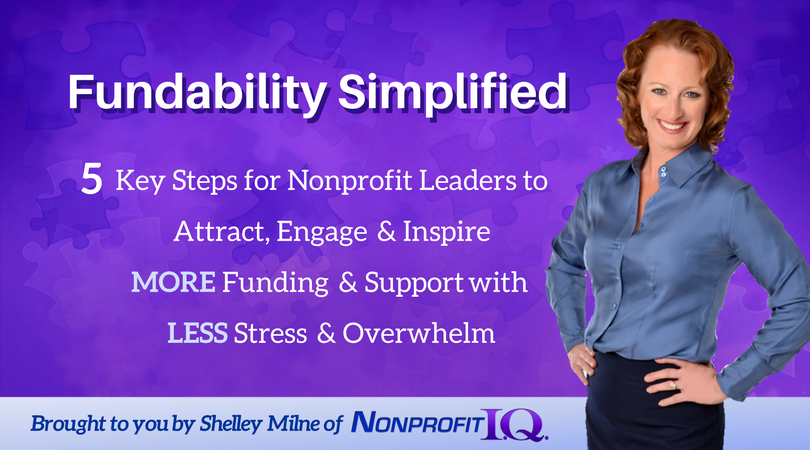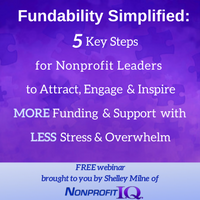Regardless of where you are in your current year, there is no better time than RIGHT NOW to improve your funding success and get crystal clear about what you want to accomplish and then begin creating a strategy to move toward your organization’s goals. I’m not going to lie to you. It takes a lot of work to create a healthy, thriving nonprofit. But, that work doesn’t have to necessarily be HARD work and it doesn’t have to take over your life. In fact, it can be quite enjoyable if you know where to focus your time and energy.
I highly recommend focusing on your organization’s long-term health and viability. After all, that’s exactly what funders are looking at when they’re assessing the fundworthiness of your nonprofit. If you rely on outside funding to support your organization and especially if you seek grants from foundations, corporate funders, United Way or government funders, this is vitally important. Many great organizations have had to reduce services, layoff good employees or shut their doors because they didn’t understand what I’m going to share with you.
Beware of the Shift!
Do you wonder why most small to mid-sized nonprofits struggle from year-to-year just to achieve or maintain funding success to sustain their existing programs and services, even when they’re producing amazing outcomes? And of those that get by without great challenge, many still fail to grow to the capacity that they’re truly needed. Why is that? My observation in working with nonprofits for over 20 years is that at some point along the way, there’s a shift in focus. Once the excitement and novelty of developing a new nonprofit wears off, the work of sustainability begins. This shift into sustainability mode is where problems often creep in. Enthusiasm is contagious and in the beginning, it’s what drives a sense of shared vision which is critically important.
However, most people (at least in the U.S.) are inflicted with “shiny object syndrome”. Heard of it? Maybe you have it too? Let’s face it, we have short attention spans. When something is no longer new and exciting, interest and enthusiasm wanes. Is this inevitable? Absolutely not!
When the leader(s) of the organization shifts into this new phase of the nonprofit life cycle, he or she often get so caught up in all of the minutia of fundraising, managing people, and putting out proverbial fires, that they forget how critically important it is to build upon the very things that created success in the first place. At this point, it becomes critically important for the head of the organization to focus some of their time and energy on those things that will create the greatest leaps forward in their business.
It’s so important to understand that neglecting to think and act proactively is death – or at the very least paralysis – for a nonprofit! This common shift into a reactive mindset is completely understandable because nonprofits need money (and oftentimes, lots of it) in order to achieve and spread their mission. When it isn’t flowing abundantly, fear and stress can set in quickly.

Here’s the rub though. While fundraising is a critical piece, it’s only one of many pieces that make up the fundability puzzle. Even so, fund development seems to commandeer so much of our nonprofits’ time and energy that it’s really difficult to find the time and energy to identify and focus on the issues that are actually causing your funding challenges in the first place.
I’ve studied the common issues that prevent nonprofit success and and have distilled these inssues down into bite-sized chunks to help nonprofits address their challenges and improve their fundability one step at a time.
First things first, however. What do I mean by the term fundability? At Nonprofit I.Q. we describe fundability as an organization’s ability to attract the human, financial, and in-kind support needed to sustain and grow its programs.
In more than two decades of working with nonprofits of all shapes and sizes, I’ve learned that each and every time an organization is having funding challenges, those funding issues are a mere symptom of challenges or deficits within the organization. Simply put, they lack fundability.
Nonprofit health is actually quite similar to our personal health in many ways. When we focus on fixing symptoms of a problem rather than addressing the root cause(s) of an issue, the symptoms may actually go away, but only temporarily. If you fail to address the underlying cause(s) of a problem, the symptoms almost always reappear and often continue to worsen and become more painful or burdensome until you’re forced to finally deal with the root cause or until it destroys you and your well-being – or your nonprofit’s. This happens so very often in the nonprofit industry and is absolutely unnecessary in my opinion!
If you knew me, you’d know that I’m all about preventative health. I think it makes a hell of a lot more sense to prevent pain, discomfort, stress and problems whenever possible, rather than fix them later. Instead of investing so much time and energy in doing more of what doesn’t work, I highly recommend diverting some of that time and energy in addressing the root causes of those funding (and other) challenges.
Think about it, if you continue doing the same old things that have not helped you reach your goals (financial or otherwise), how can you possibly improve your outcomes?
When you optimize your organization’s fundability, you address the primary areas that so many nonprofits neglect and you begin creating the conditions necessary for long-term success. Isn’t that awesome?

Create Incremental Step-by-Step Changes

I believe in keeping things as simple as possible because let’s face it, none of us have time to waste on B.S., right? Below, I briefly discuss the first and most critical pieces of fundabililty that the vast majority of small to mid-sized nonprofits neglect.
When you start here, you’ll save an enormous amount of time and frustration. You’ll begin to make an enormous difference in your organization’s fundability and you’ll start moving toward your goals much faster and more productively.
Step 1: Cultivate a Culture of Excellence
The first step in my Fundability Formula focuses on People. Simple, right? Let me ask you this. Are you, your staff and your board members excited and engaged or is it a constant struggle to get your key team members to do what you think they should be doing to create success for your organization? Take an honest look at the culture of your organization and team. Strong, healthy nonprofits start with inspiring leadership that engage their people toward committed action. If that does not describe you or your organization in its current state of being, you have the power to begin immediately focusing on transforming yourself and your organization. All it takes is a commitment to success and excellence, some tenacity and ACTION.
Once you’ve made the decision to do so, it’s amazing how the universe begins conspiring in your favor to bring you the information and resources necessary to help you achieve your goals. Here are a couple of tips to help keep you moving toward success. Focus on the end result – what you want (NOT what you don’t want). Keep it simple, take it step by step and follow the example of others who’ve been successful.
Next, consider the following questions and write down your answers in a journal (paper or online) that you have easy access to everyday so you can reflect upon them:
1. What is the culture of my organization? Is it supportive, cohesive, and happy or is it fearful, critical and hostile?
2. What does leadership excellence mean to me and am the kind of leader that I’d love to follow? Why or why not?
3. How can I help create or contribute to leadership excellence within my organization?
4. How can my team better leverage our time and energy to attract more funding and support?
5. Do I have a healthy work/life balance and do an excellent job of mitigating challenges both personally and professionally so I can maintain balance and happiness in all aspects of my life or am I stressed out, overwhelmed, and headed toward burnout? What about my team members?
Coming Soon to a Computer Near You!
If you enjoyed – or at least resonated with what was said in this blog post, there’s more great stuff coming your way. For a deeper dive into cultivating a culture of excellence in your organization, join me for my upcoming webinar. Click below to sign up for my next FREE online training.



